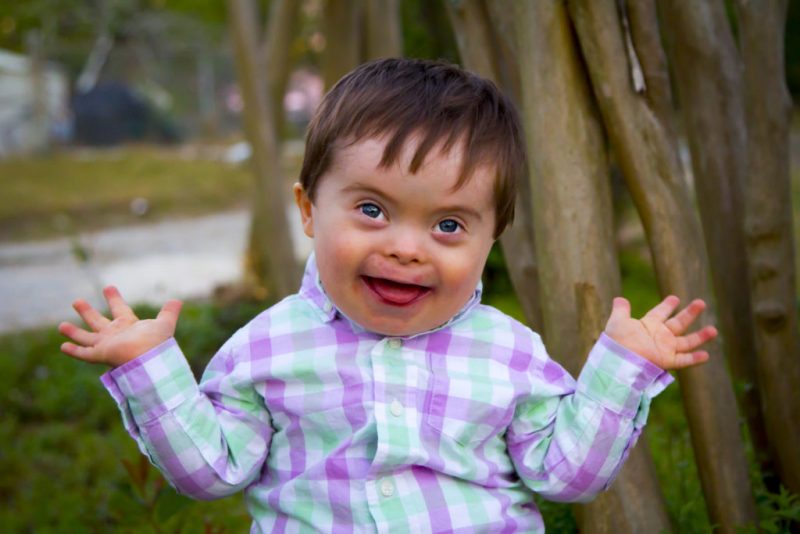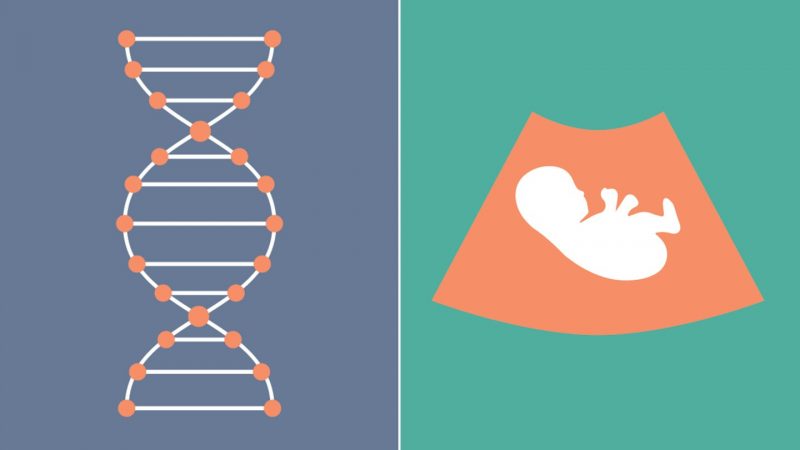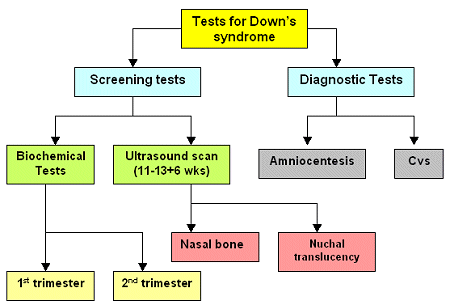Down syndrome is a genetic disorder caused when abnormal cell division results in extra genetic material from chromosome 21. This genetic disorder, which varies in severity, causes lifelong intellectual disability and developmental delays, with characteristic facial features and in some people, it causes heart defects and other health problems.

Down syndrome is the most common genetic disorder and the cause of learning disabilities in children. Down syndrome occurs in about 1 in 800 newborns. Although women of any age can have a child with Down syndrome, the chance of having a child with this condition increases, as a woman gets older.
Genetic basis of Down syndrome
Human cells normally contain 23 pairs of chromosomes. One chromosome in each pair comes from your father, the other from your mother.
Down syndrome results when abnormal cell division involving chromosome 21 occurs. These cell division abnormalities result in extra genetic material from chromosome 21, which is responsible for the occurrence of Down syndrome. This type of error accounts for 95% of cases of the Down syndrome. In rest of 5% cases, it may be due to translocation error where a part of chromosome 21 becomes attached (translocated) on to another chromosome. These children have the usual two copies of chromosome 21, but they also have additional material from chromosome 21 attached to the translocated chromosome.

Is it inherited?
Most of the time, it is sporadic, not inherited. It is caused by a mistake in cell division during the development of the egg, sperm or embryo.
Translocation Down syndrome is the only form of the disorder that can be passed from parent to child. However, only about 4 percent of children with Down syndrome have a translocation. And only about one-third of these children inherited it from one of their parents.
Risk Factors
Some parents have a greater risk of having a baby with Down syndrome. Risk factors include:
- Advancing Maternal Age-
A woman’s chances of giving birth to a child with Down syndrome increases with age because older eggs have a greater risk of improper chromosome division. By age 35, a woman’s risk of conceiving a child with Down syndrome is about 1 in 350. BY age 40, the risk is about 1 in 100, and by age 45, the risk is about 1 in 30. However, most children with Down syndrome are born to women under age 35 because younger women have far more babies.
- Having had one child with Down syndrome-
Typically, a woman who has one child with Down syndrome has about a 1% chance of having another child with Down syndrome.
- Being carriers of the genetic translocation for Down syndrome-
Both men and women can pass the genetic translocation for Down syndrome on to their children.
Symptoms
Down syndrome symptoms vary from person to person and can range from mild to severe. No matter the severity of the condition, persons with Down syndrome have a widely- recognized appearance. Common physical signs include:
- Flattened facial features
- Small head
- Short neck
- Protruding tongue
- Upward slanting eyes, unusual for the child’s ethnic group
- Unusually shaped or small ears
- Poor muscle tone
- Broad, short hands with a single crease in the palm
- Relatively short fingers and small hands and feet
Children may also have delayed mental and social development. Common Problems may include- impulsive behavior, Poor Judgment, Short attention span and slow learning.
 Complications or health problems associated with Down syndrome-
Complications or health problems associated with Down syndrome-
Children With Down syndrome can have a variety of complications, some of which become more prominent as they get older, such as:
- Heart defects- About half the children with Down syndrome are born with some type of heart defect. These heart problems can be life-threatening and may require surgery in early infancy.
- Leukemia-Young Children with Down syndrome have an increased risk of leukemia.
- Infectious diseases- Because of abnormalities in their immune systems, those with Down syndrome are much more at risk of infectious diseases, such as pneumonia.
- Dementia- People with Down syndrome have a greatly increased risk of dementia. Having Down syndrome also increases the risk of developing Alzheimer’s disease.
- Other problems- Down syndrome may also be associated with other health conditions, including gastrointestinal blockage, thyroid problems, seizures, ear infections, hearing loss, skeletal problems, and poor vision.
Tests and diagnosis
The American College of Obstetricians and Gynecologists recommends offering the option of screening tests and diagnostic tests for Down syndrome to all pregnant women, regardless of age.
- Screening tests- can indicate the likelihood a mother is carrying a baby with Down syndrome.
- Diagnostic tests- can identify whether your baby has Down syndrome or not.
Screening tests during pregnancy
Screening for Down syndrome is offered as a routine part of antenatal care. This test can identify the pregnancies, which are at higher risk of having children with Down syndrome, and they can help you make decisions about more-specific diagnostic tests and the course of the pregnancy.
The first trimester combined test, which is done in two steps, includes:
- Blood Test- This blood test measures the levels of pregnancy-associated plasma protein-A (PAPP-A) and the pregnancy hormone known as human chorionic gonadotropin (HCG). Abnormal levels of PAPP-A and HCG may indicate a problem with the baby.
- Ultrasound– Ultrasound is done at 11-14 Weeks (NT scan) for measurement of nuchal translucency, nasal bone, tricuspid regurgitation, and ductus venous Doppler.
Using your age and the results of the blood test and the ultrasound, we can estimate your risk of having a baby with Down syndrome.
When a Women comes late (after 14 weeks), screening test includes blood test (quadruple test) along with USG for soft markers upto 15-20 weeks.

Cell-Free Fetal DNA analysis (NIPT)
The cell-free fetal DNA test checks for fetal DNA circulating in the mother’s blood. This test is usually recommended for women who have a higher risk of having a baby with Down syndrome or in response to risk detected by one of the previous tests. The mother’s blood can be tested during pregnancy after 10 weeks gestation.
This test appears to be much more specific than other screening methods for Down syndrome. If this screening test indicates a high risk of Down syndrome, a more invasive diagnostic test may be used to determine whether your baby actually has Down syndrome.
Diagnostic tests during pregnancy
If your screening test results are positive or you’re at high risk of having a baby with Down syndrome, you might consider for more testing to confirm the diagnosis.
Diagnostic tests that can identify Down syndrome include:
- Amniocentesis- A sample of the amniotic fluid surrounding the fetus is withdrawn through a needle inserted into the mother’s uterus. This Sample is then used to analyze the chromosomes of the fetus. It is performed in the second trimester, after 16 weeks of pregnancy.
- Chorionic villus sampling (CVS)- in CVS, cells are taken from the placenta and used to analyze the fetal chromosomes. Typically performed in the first trimester, after 11 weeks of pregnancy.
Management
If your child has Down syndrome, you’ll likely rely on a team of specialists that, depending on your child’s particular need, will provide your child medical care and help him or her develop skills as fully as possible.
There is no cure For Down syndrome.


